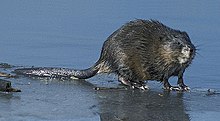Musk

Musk is a class of aromatic substances commonly used as
Natural musk was used extensively in
Modern use of natural musk pods occurs in traditional Chinese medicine (TCM). TCMs in China, save for specially exempt drugs, use a synthetic version of undisclosed composition created in 1994. The process was given State Science and Technology Progress Award First Class in 2015.[7]
Natural sources
Musk deer

The musk deer belongs to the family Moschidae and lives in Tibet,[8] India, Nepal, Pakistan, Afghanistan, China, Siberia, Mongolia, Manchuria, Korea and North Vietnam. The musk pod, a preputial gland in a pouch, or sac, under the skin of the abdomen of the male musk deer, is normally obtained by killing the male deer through traps laid in the wild. Upon drying, the reddish-brown paste inside the musk pod turns into a black granular material called "musk grain", which is then tinctured with alcohol. The aroma of the tincture gives a pleasant odor only after it is considerably diluted. No other natural substance has such a complex aroma associated with so many contradictory descriptions; however, it is usually described abstractly as animalistic, earthy and woody[5] or something akin to the odor of baby's skin.[9]
Musk has been a key constituent in many perfumes since its discovery, being held to give a perfume long-lasting power as a fixative. Today, the trade quantity of the natural musk is controlled by the Convention on International Trade in Endangered Species of Wild Fauna and Flora (CITES), but illegal poaching and trading continues.[9]
-
Moschus moschiferus, Siberian musk deer
-
"Musk-cat", woodcut from Hortus Sanitatis, 1491
Other animals

Muskrat (Ondatra zibethicus), a rodent native to North America, has been known since the 17th century to secrete a glandular substance with a musky odor.[10] A chemical means of extracting it was discovered in the 1940s, but it did not prove commercially worthwhile.[10]
Glandular substances with musk-like odors are also obtained from the
In crocodiles, there are two pairs of musk glands, one pair situated at the corner of the jaw and the other pair in the cloaca.[11] Musk glands are also found in snakes.
Plants
Some plants such as Angelica archangelica or Abelmoschus moschatus produce musky-smelling macrocyclic lactone compounds. These compounds are widely used in perfumery as substitutes for animal musk or to alter the smell of a mixture of other musks.
The plant sources include the musk flower (
Artificial compounds

Since obtaining the deer musk requires killing the endangered animal, nearly all musk fragrance used in perfumery today is synthetic, sometimes called "white musk". They can be divided into three major classes: aromatic nitro musks, polycyclic musk compounds, and macrocyclic musk compounds.[5] The first two groups have broad uses in industry ranging from cosmetics to detergents. However, the detection of the first two chemical groups in human and environmental samples as well as their carcinogenic properties initiated a public debate on the use of these compounds and a ban or reduction of their use in many regions of the world. Macrocyclic musk compounds are expected to replace them since these compounds appear to be safer.[5]
Other uses
Musk is often associated with religious significance. In
Musk has been used to attract wild animals, including in man-made perfume mixtures. For example, in 2018 Indian authorities used the perfume Obsession by Calvin Klein to attract and thus trap a wild tiger that had attacked and killed more than a dozen humans.[17]
See also
Notes
- ^ a b "Merriam-Webster's Online Dictionary: musk". Merriam-Webster. Retrieved 2007-04-07.
- ISBN 2-252-03277-4.
- ^ Harper, Douglas. "musk". Online Etymology Dictionary.
- ISBN 2-252-03277-4.
- ^ ISBN 3-540-43706-1.
- ^ "Musk: Its Pharmacological Action and Therapeutic Uses" (PDF).
- ^ "迟来的大奖 人工麝香终获国家科技进步一等奖--科技--人民网" [Late grand award; artificial musk finally receives State Science and Technology Progress Award First Class]. scitech.people.com.cn (in Chinese).
- .
- ^ ISBN 0-8493-2372-X.
- ^ ISBN 0-7514-0403-9.
- ISBN 0-444-51863-0.
- ^ "Archived copy". Archived from the original on 2022-11-20. Retrieved 2022-04-06.
{{cite web}}: CS1 maint: archived copy as title (link) - ^ Griffith, Sidney (2021). "The Narratives of "the Companions of the Cave," Moses and His Servant, and Dhū 'l-Qarnayn in Sūrat al-Kahf". Journal of the International Qur'anic Studies Association. 6: 137–166.
- ISBN 9780553815498– via Google Books.
- ^ Dussauce, Hippolyte (February 18, 1868). "A Practical Guide for the Perfumer: Being a New Treatise on Perfumery the Most Favorable to Beauty Without Being Injurious to the Health, Comprising a Description of the Substances Used in Perfumery, and the Formulæ of More Than One Thousand Preparations ..." H. C. Baird: London, Trübner & Company – via Google Books.
- ISBN 9782305096186– via Google Books.
- ^ "Calvin Klein's Obsession Could Be The Trick To Catching A Tiger". NPR. 14 October 2018. Retrieved 18 October 2018.
This article incorporates text from a publication now in the public domain: Chisholm, Hugh, ed. (1911). "Musk". Encyclopædia Britannica. Vol. 19 (11th ed.). Cambridge University Press. p. 90.
Further reading
- Borschberg, Peter, "O comércio europeu de almíscar com a Ásia no inicio da edad moderna - The European Musk Trade with Asia in the Early Modern Period", Revista Oriente, 5 (2003): 90-9.
- Borschberg, Peter, "Der asiatische Moschushandel vom frühen 15. bis zum 17. Jahrhundert", in Mirabilia Asiatica, edited by J. Alves, C. Guillot and R. Ptak. Wiesbaden and Lisbon: Harrassowitz-Fundação Oriente (2003): 65–84.


